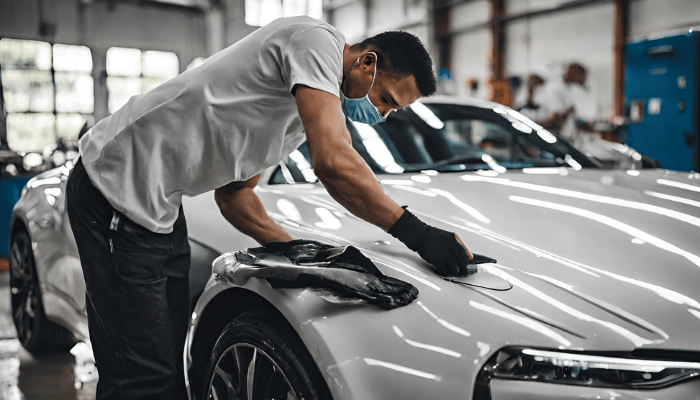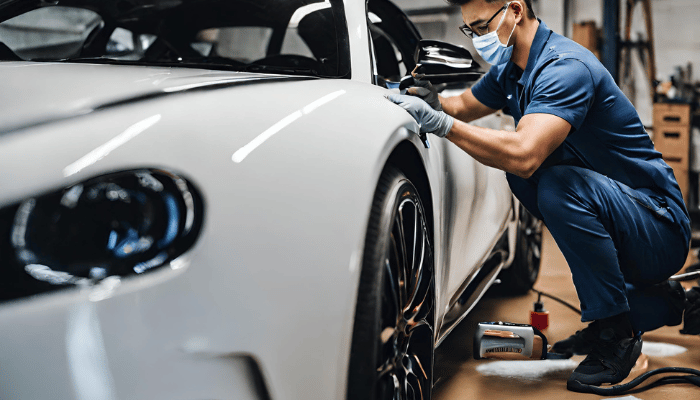I Didn’t Buff the Ceramic Coating Off in Time! What Should I Do?
Introduction
A liquid polymer, ceramic coating has become a car enthusiast’s must-have product around the world. No wonder, then, is it? When affixed to a vehicle, it combines with the paint to form a permanent shell that can protect against as much as the sun’s ultraviolet rays, scratches, chemical spots, and even graffiti.
However, the use of a ceramic coating is not so straightforward, just apply the product and you’re done. Most of it has to be done meticulously, carefully prepared, applied, and most of all, buffed in good time. Dishing out Surface buffing is an indispensable process in the coating of ceramics, making the surface smooth and shiny. It assists in polishing away excess product and creates a smooth, even, and glossy finish.
But what if you neglected the essential buffing step? What happens if you don’t remove the ceramic coating in time? Many people have the same problem, and this can result in unsightly streaks and high spots in the paint on your car. Apart from impairing the appearance of your vehicle, these imperfections can also be hard to smooth out once the coating has hardened.
But don’t despair. If this should be your predicament, help is at hand. When you don’t buff the ceramic coating off in time, however, you can use this blog to walk you through how to correct the situation and get your car’s finish to once again look like new.

The Importance of Buffing Ceramic Coating
Buff polishing is therefore an essential link in the process of applying ceramic coating. A soft cloth or pad is used to rub off the excess product and polish the surface into an exceptionally smooth finish. Here’s why buffing ceramic coating is so important:
Ensures a Smooth Finish: Buffing also creates an even finish of glossy ceramic coating. If insufficient buffing is done, the coating will dry too quickly and the appearance will be irregular, with high and low places or streaks.
Prevents Hardening of Excess Coating: The moment ceramic coating is exposed to air, it begins to cure (or harden). The coating also tends to harden on the surface if it is not buffed off in time.
Maximizes the Lifespan of the Coating: The right kind of buffing also serves to extend the life of the ceramic coating. This keeps the coating adhering firmly to the paint, which may improve the latter’s durability and protective qualities.
Enhances the Look of the Vehicle: A well-buffed ceramic coating adds to the vehicle’s sparkling appearance. The glossy finish brings out the color of the paint and gives the vehicle a fresh appearance.
What if the Ceramic Coating was Not Polished in Time?
The process of buffing is also crucial to the ceramic coating procedure. Excess product is wiped away with a soft cloth (usually microfiber) to leave a smooth finish. Here’s why buffing ceramic coating is so important:
Ensures a Smooth Finish: Buffing will polish the ceramic coating to a glossy finish. The coating will dry with high spots or streaks if the buffing isn’t done properly.
Prevents Hardening of Excess Coating: As soon as the ceramic coating touches the air, it begins to set (or harden). However, if it is removed slowly enough, the coating can be very tough to get off after it hardens on the surface.
Maximizes the Lifespan of the Coating: With proper buffing, ceramic coating can be used to good effect for an extended period. All this is to ensure that the coating effectively bonds with the paint to enhance the paint’s durability and protectiveness.
Enhances the Look of the Vehicle: A buffed-up ceramic coating makes the vehicle still more attractive. This gives it a high-gloss shine that makes the color of the paint stand out and also gives the vehicle a fresh, new look that could pass for a showroom.

Ceramic Coating Prevents Future Problems
The key to avoiding problems with ceramic coating is taking precautions during the coating process. Here’s a more detailed guide on how to prevent future issues:
Work in Small Sections: The ceramic coating must be applied in small sections instead of applying the coating to the entire vehicle at once. That way you can work on one area at a time and before the ceramic coating hardens you can buff it away. For instance, you could begin with the hood, and follow it downward, saying the roof and so forth. Such a step-by-step approach will prevent high spots or streaks. The surface will be smooth and level.
Use the Right Tools: Your tools can have a profound impact on the successful application of the ceramic coating. Use a high-quality microfiber towel to buff off the ceramic coating. They’re soft and non-abrasive, so they can soak up extra product without damaging the paint on your vehicle. What’s more, selecting a high-quality applicator pad can provide an even application of the ceramic coating.
Monitor the Temperature and Humidity: Where you apply the ceramic coating also affects how fast it dries. Lastly, high temperatures and humidity improve the curing rate, and the coating must be buffed off before it hardens. But on the other hand, low temperatures and humidity can delay the curing. Hence, you must pay attention to the temperature and humidity around the working area and allow time for buffing.
Follow the Manufacturer’s Instructions: The application and buffing directions vary for each ceramic coating product. Thus it is important to read and heed the manufacturer’s instructions. They will tell you how long to wait before buffing the coating off, how much product to use, and so on. By following these steps, a ceramic coating can be successfully applied.
If you keep these points in mind, you can avoid the common problems that can result from the ceramic coating, and you can have your car looking smooth, glossy, and durable. He reminds us that ceramic coating is a matter of preparation, patience, and proper buffing.
Coping With Different Ceramic Coating Conditions
The process of applying ceramic coating is not a monotone chore. The process of application and curing can be affected by a variety of conditions. Here’s a more detailed guide on how to navigate these conditions:
High Temperature and Humidity
However, under high temperature and humidity conditions, the ceramic coating can cure quickly. This means that it is not always possible to polish it away in time. Here are some strategies to manage this:
Time of Application: You might as well try applying the coating in the early morning or late evening when the weather is generally cooler. This will speed up the curing, allowing the coating to be buffed more quickly.
Choice of Product: There are some products with ceramic coating that have a longer working time, and this has advantages in hot and humid conditions. They are cured more slowly, so you have even more time to polish off the excess layer.
Working in Sections: Breaking up into smaller areas can better control the faster curing times. You have to buff off the coating while it is still tacky, and with only one small area to concentrate on at a time, you can do good work.
Low Temperature
However low temperatures can delay the curing of the ceramic coating. This can result in the coating staying damp for too long, and picking up dust and other particles. Here’s how to prevent this:
Heated Environment: Where possible, apply the ceramic coating in the garage or similar facility. This can accelerate the curing process.
Fast-Curing Products: Maybe it’s time to think about using a ceramic coating product that cures quickly. But these products are of help in cold weather because they shorten the period the coating is damp.
Incorrect Application
If too much or too little ceramic coating is used, there will be problems. Here’s how to avoid this:
Follow Instructions: Be sure always to use the amount indicated by the manufacturer’s instructions. This can prevent you from applying too much or too little coating.
Even Application: The ceramic coating can then be applied with an applicator pad. This will evenly spread the product over the exterior of the vehicle.
Buffing: Be sure to buff the coating thoroughly after using it. It allows any extra product to drip off and avoids high spots and streaks.
Knowing how the various conditions impact the application of the coating can help you prepare for it properly. The secret of a successful ceramic coating job is preparation, patience, and buffing.

Advanced Buffing Techniques
If there are resistant high spots or streaks left from the ceramic coating, there’s no need to worry. Several advanced buffing techniques can help you rectify the situation:
Wet Sanding: One technique is wet sanding, using fine-grit sandpaper and a little water to sand the high points. The water also serves as a lubricant and prevents the sandpaper from scraping the surface. Wet sanding means wetting the surface and applying light, even pressure at all times. Begin with the higher number (i.e. coarser) grit paper and switch to a lower number (finer) paper only if necessary. They must be careful that they don’t damage the paintwork underneath during this process.
Machine Polishing: Another method of taking down high spots is machine polishing. The dual-action polisher, or machine polisher, incorporates both a rotating and oscillating motion to apply polish to a surface. This motion distributes the polish evenly and prevents the formation of swirl marks or burning through the paint. If one uses a machine polisher, one must choose the proper type of pad and polish. The high spots are usually removed using a relatively fine abrasive polish on a softer pad. Work slowly and carefully, never holding the polisher in one place too long.
Ceramic Coating Remover: Some manufacturers sell a product that will remove the ceramic coating. Most of these products also have a chemical in them that dissolves the ceramic coating, so it can be removed. Applying a ceramic coating remover is as easy as lathering it on the damaged section, waiting for the prescribed time, and then wiping it away with a microfiber cloth. However, when using these products, you must always respect the recommendations of the manufacturer, or otherwise risk damaging the base coat of paint.
Just remember, you should not try any of these advanced techniques unless you are comfortable with them and have the proper equipment and experience. But if you are at all doubtful, you must see a doctor. A professional detailer will possess the know-how and equipment to remove the ceramic coating to address the problem.
Conclusion
Protect your car’s paintwork with a ceramic coating. This isn’t going to harm your car. Nevertheless, it is an exacting process, especially when it comes to buffing the coating. If you don’t polish (buff) the ceramic coating off in time, there will be high spots and streaks, which will spoil the appearance of your car.
Don’t worry if you didn’t buff the ceramic coating away in time. You can save it by reapplying the coating, using a clay bar, or even having the job done by a professional. Of course, with the right techniques and tools, similar problems can be avoided in the future.
The basis of the art of applying a ceramic coating is preparation, patience, and buffing. If you obey the manufacturer’s instructions when applying it in an appropriate set of conditions, your vehicle will end up with a beautiful, glossy, durable finish. Even if some problems crop up, don’t despair. However, if one is properly educated and has the correct principles, one can correct these problems and bring one’s vehicle’s finish back to its original condition.
